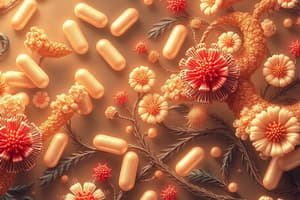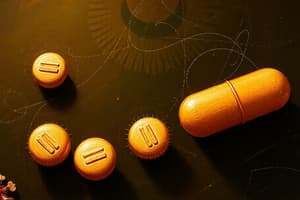Podcast
Questions and Answers
What is a common effect of antifungal drugs on fungal membranes?
What is a common effect of antifungal drugs on fungal membranes?
- They promote cell growth.
- They increase cell constituent retention.
- They disrupt membrane permeability. (correct)
- They enhance membrane stability.
What can cause the development of superinfections?
What can cause the development of superinfections?
- The destruction of drug-sensitive strains by treatments. (correct)
- The use of topical antifungals.
- Regular consumption of probiotics.
- Inadequate hydration during antibiotic use.
How can the emergence of drug resistance be prevented?
How can the emergence of drug resistance be prevented?
- Giving only one drug at a time.
- Only using drugs after resistance develops.
- Using a single drug at lower doses.
- Administering drugs in high concentrations when necessary. (correct)
Which of the following is not a class of antiviral drugs mentioned?
Which of the following is not a class of antiviral drugs mentioned?
Why are relatively few antiviral drugs developed?
Why are relatively few antiviral drugs developed?
Which enzyme is targeted by herpes virus inhibitors?
Which enzyme is targeted by herpes virus inhibitors?
What function do Fusion inhibitors serve in anti-HIV treatment?
What function do Fusion inhibitors serve in anti-HIV treatment?
What is a strategy for making anti-HIV drugs more effective?
What is a strategy for making anti-HIV drugs more effective?
What is the therapeutic index in the context of antimicrobial drugs?
What is the therapeutic index in the context of antimicrobial drugs?
Which of the following describes a broad-spectrum antibiotic?
Which of the following describes a broad-spectrum antibiotic?
What role does sulfonamide play in antimicrobial therapy?
What role does sulfonamide play in antimicrobial therapy?
What method is used to determine the minimal inhibitory concentration (MIC) of an antimicrobial agent?
What method is used to determine the minimal inhibitory concentration (MIC) of an antimicrobial agent?
Which of the following is a notable discovery in the history of antibiotics?
Which of the following is a notable discovery in the history of antibiotics?
Which structural component is essential for the bioactivity of penicillins?
Which structural component is essential for the bioactivity of penicillins?
How can antimicrobial resistance originate?
How can antimicrobial resistance originate?
What characteristic of a drug is most important for its therapeutic effectiveness?
What characteristic of a drug is most important for its therapeutic effectiveness?
What mechanism does vancomycin use to combat bacterial infections?
What mechanism does vancomycin use to combat bacterial infections?
What is a common side effect observed with excessive dosages of antimicrobial drugs?
What is a common side effect observed with excessive dosages of antimicrobial drugs?
Which of the following antibiotics is primarily ineffective against eukaryotic fungi?
Which of the following antibiotics is primarily ineffective against eukaryotic fungi?
In the Kirby-Bauer method, how is antimicrobial susceptibility assessed?
In the Kirby-Bauer method, how is antimicrobial susceptibility assessed?
Which of the following antibiotics is known for its activity against tuberculosis?
Which of the following antibiotics is known for its activity against tuberculosis?
Flashcards
Fungal infections
Fungal infections
Can be categorized into superficial (e.g., skin) and systemic infections.
Antifungal drugs action
Antifungal drugs action
Target fungal membrane sterols, disrupting permeability and causing cell leakage.
Superinfection cause
Superinfection cause
Drug treatment can destroy drug-sensitive strains, allowing drug-resistant pathogens to multiply.
Preventing drug resistance
Preventing drug resistance
Signup and view all the flashcards
Antiviral drug challenge
Antiviral drug challenge
Signup and view all the flashcards
Anti-HIV drug approach
Anti-HIV drug approach
Signup and view all the flashcards
Anti-DNA virus drugs
Anti-DNA virus drugs
Signup and view all the flashcards
Reverse transcriptase inhibitors
Reverse transcriptase inhibitors
Signup and view all the flashcards
Chemotherapeutic Agents
Chemotherapeutic Agents
Signup and view all the flashcards
Antibiotics
Antibiotics
Signup and view all the flashcards
Selective Toxicity
Selective Toxicity
Signup and view all the flashcards
Therapeutic Dose
Therapeutic Dose
Signup and view all the flashcards
Toxic Dose
Toxic Dose
Signup and view all the flashcards
Therapeutic Index
Therapeutic Index
Signup and view all the flashcards
Minimal Inhibitory Concentration (MIC)
Minimal Inhibitory Concentration (MIC)
Signup and view all the flashcards
Minimal Lethal Concentration (MLC)
Minimal Lethal Concentration (MLC)
Signup and view all the flashcards
Disk Diffusion Test
Disk Diffusion Test
Signup and view all the flashcards
Kirby-Bauer Method
Kirby-Bauer Method
Signup and view all the flashcards
E-test
E-test
Signup and view all the flashcards
Penicillins
Penicillins
Signup and view all the flashcards
Sulfonamides
Sulfonamides
Signup and view all the flashcards
Drug Resistance
Drug Resistance
Signup and view all the flashcards
R Plasmids
R Plasmids
Signup and view all the flashcards
Study Notes
Chemotherapeutic Agents
- Chemical agents used to treat diseases
- Destroy pathogenic microbes or inhibit their growth within a host
- Most are antibiotics
- Antimicrobial products or their derivatives kill susceptible microbes or inhibit their growth
- The effect is potentially harmful
Development of Chemotherapy
- Paul Ehrlich (1904) developed the concept of selective toxicity
- Identified dyes that effectively treated African sleeping sickness
- Sahachiro Hato (1910), working with Ehrlich, identified arsenic compounds that effectively treated syphilis
- Gerhard Domagk, and Jacques and Therese Trefouel (1935) discovered sulfonamides and sulfa drugs (antibiotics)
Penicillin
- First discovered by Ernest Duchesne (1896), but the discovery was lost
- Accidentally discovered by Alexander Fleming (1928)
- Observed penicillin activity on contaminated plates
- Did not think it could be developed further
- Effectiveness demonstrated by Florey, Chain, and Heatley (1939)
Later Discoveries
- Streptomycin, an antibiotic active against tuberculosis, was discovered by Selman Waksman (1944)
- Nobel Prize awarded to Waksman in 1952 for this discovery
- By 1953, chloramphenicol, terramycin, neomycin, and tetracycline were isolated
General Characteristics of Antimicrobial Drugs
- Selective Toxicity: Ability of a drug to kill or inhibit a pathogen while damaging the host as little as possible
- Therapeutic Dose: The drug level required for clinical treatment
- Toxic Dose: The drug level at which the drug becomes too toxic for a patient (produces side effects)
- Therapeutic Index: The ratio of toxic dose to therapeutic dose. A higher therapeutic index suggests more selective toxicity
Antimicrobial Drug Properties
- Cidal: Kills the microorganism
- Static: Inhibits microorganism growth
- Broad-spectrum: Attacks many different pathogens
- Narrow-spectrum: Attacks only a few different pathogens
- Lists examples of specific drugs, their primary effects, spectrum, and side effects
Microbial Sources of Antibiotics
- Lists various microorganisms and the antibiotics derived from them
Determining the Level of Antimicrobial Activity
- MIC (minimal inhibitory concentration): The lowest concentration of a drug that inhibits the growth of a pathogen
- MLC (minimal lethal concentration): The lowest concentration of a drug that kills a pathogen
- Techniques for testing MIC and MLC are also described.
Dilution Susceptibility Tests
- Involves inoculating media containing different drug concentrations
- Broth or agar with lowest concentration showing no growth is the MIC
- If broth is used, tubes showing no growth can be subcultured into a drug-free medium
- Broth from which the microbe can't be recovered is the MLC
Disk Diffusion Tests
- Disks impregnated with specific drugs are placed on inoculated agar plates.
- Drug diffuses into the agar, creating a concentration gradient.
- Clear zones (no growth) around the disks are observed
Kirby-Bauer Method
- Standardized method for carrying out disk diffusion tests
- Sensitivity and resistance are determined using tables correlating zone diameter to microbial resistance.
- Table values are plotted and used to determine if drug concentrations in the body will be effective
Measuring Antimicrobial Sensitivity
- Detailed description of testing procedures
Measuring Drug Concentrations in the Blood
- Drug concentration at infection site must be higher than the MIC for effectiveness
- Microbiological, chemical, immunological, enzymatic, or chromatographic assays can be used to determine drug concentration in the blood
Mechanism of Action of Antimicrobial Agents
- Drugs target functions needed for pathogen reproduction or survival
- Highly specific targeting to pathogen leads to higher therapeutic index
Mechanisms of Antibacterial Drug Action
- Details the mechanisms of action of various antibacterial drugs, categorizing them by their target in the bacterial cell
Modes of Antimicrobial Action
- Diagram illustrating the major modes of antimicrobial action, targeting various bacterial processes
Competitive Inhibitors
- Sulfonamides (sulfa drugs): Inhibit folic acid synthesis.
- Broad spectrum
Factors Influencing the Effectiveness of Antimicrobial Drugs
- Ability of the drug to reach the site of infection
- Susceptibility of the pathogen to the drug
- Ability of the drug to reach concentrations in the body that exceed the pathogen's MIC
Ability of Drug to Reach Site of Infection
- Depends on the mode of administration
- Examples: oral (destroyed by stomach acid), topical (skin surface), and parenteral (injection) routes
Inhibitors of Cell Wall Synthesis
- Penicillins:
- 6-aminopenicillanic acid derivatives
- Differ in side chains attached to amino group
- Crucial feature is the β-lactam ring, essential for bioactivity
- Many penicillin-resistant organisms produce β-lactamase (penicillinase) breaking a bond in this ring
Mode of Action of Penicillins
- Blocks the enzyme that catalyzes transpeptidation (cross-link formation in peptidoglycan)
- Prevents the synthesis of complete cell walls, leading to lysis of growing bacteria that are synthesizing new peptidoglycan
Cephalosporins
- Structurally and functionally similar to penicillins
- Broad-spectrum antibiotics
- Useful for patients allergic to penicillin
- Four categories based on their spectrum of activity
Vancomycin and Teicoplanin
- Glycopeptide antibiotics
- Inhibit cell wall synthesis
- Important for treatment of antibiotic-resistant staphylococcal and enterococcal infections
- Previously considered a "drug of last resort".
Protein Synthesis Inhibitors
- Many antibiotics bind to bacterial ribosomes.
- Binding can be to either the 30S or 50S ribosomal subunit.
- Other antibiotics interfere with steps in protein synthesis, including aminoacyl-tRNA binding, peptide bond formation, mRNA reading, and translocation.
Nucleic Acid Synthesis Inhibitors
- Inhibit DNA replication, transcription, or RNA polymerase activity.
- Drugs (e.g., Rifampin) are less selective for bacteria compared to other antibiotics because the mechanisms for nucleic acid synthesis are similar.
Antifungal Agents
- Nystatin (mycostatin): Yeasts
- Griseofulvin (Grisactin): Dermatophyte fungi
- Amphotercin B (Fungizone): Systemic fungi.
Antifungal Characteristics
- Many antifungal drugs are quite toxic to humans.
- Most fungi have a detoxification system that likely modifies many antibiotics by hydroxylation.
- Fungal infections are typically subdivided into superficial mycoses and systemic mycoses.
- Most antifungal drugs interfere with sterols in fungal membranes, causing disruption of membrane permeability and cell leakage.
Superinfection
- Development and spread of drug-resistant pathogens, often caused by the original drug treatment that destroys the sensitive strains.
- Examples such as pseudomembranous enterocolitis due to Clostridium difficile
Preventing Emergence of Drug Resistance
- Use high drug concentrations when necessary
- Administer multiple drugs at the same time, if needed
- Use drugs only when medically necessary
- Development of new drugs
- Use of bacteriophages to target bacterial diseases
Antiviral Drugs
- Relatively few because of difficulty targeting viral replication.
Antiviral Examples
- Amantadine: Prevents influenza infections by blocking viral penetration and uncoating
- Drugs inhibiting herpes virus enzymes involved in DNA or RNA synthesis & function (e.g., acyclovir, adenine arabinoside, foscarnet)
- Broad-spectrum anti-DNA virus drugs (e.g., cidofovir) inhibit viral DNA polymerase
Anti-HIV Drugs
- Reverse transcriptase (RT) inhibitors (nucleoside and non-nucleoside).
- Protease inhibitors mimic peptide bonds attacked by HIV protease.
- Fusion inhibitors prevent HIV entry into cells.
- Most successful strategies combine drug cocktails to combat resistance.
Mechanisms of Drug Resistance
- Exclusion of drug (drug can't bind or penetrate).
- Drug efflux (pumping the drug out).
- Drug inactivation (chemical modification by pathogen).
- Alteration of target (enzyme/organelle).
- Use of alternative pathways or increase in target metabolite production.
Origin of Resistance Genes
- Resistance genes can be chromosomal or on plasmids.
- Plasmids are small DNA molecules existing separately or integrated into the chromosome.
Studying That Suits You
Use AI to generate personalized quizzes and flashcards to suit your learning preferences.




